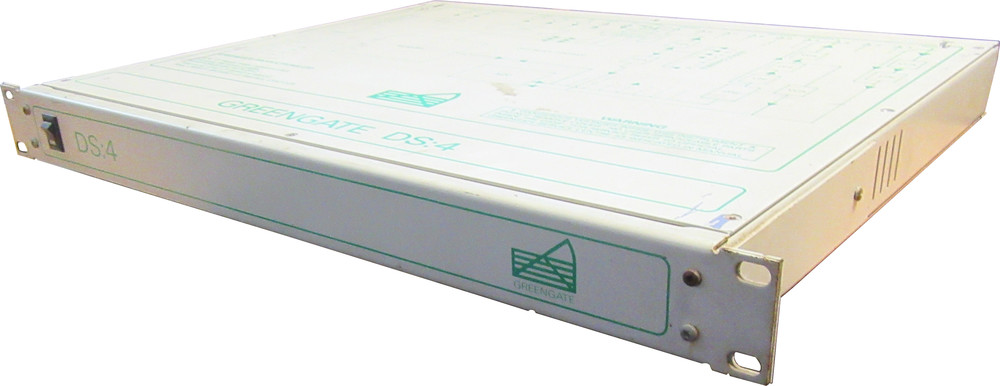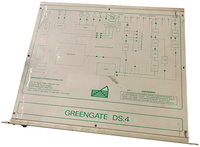Greengate DS:4 Sampler Module
| Home > Browse Our Collection > Peripherals > Miscellaneous > Greengate DS:4 Sampler Module |
|
The Greengate DS4 is a sound sampler module used to record sound into digital memory and allow it to be played back via a music keyboard. The DS4 is used in conjunction with a custom card installed in an Apple IIGS computer. (Also in the collection) The Story of the Greengate by Colin Holgate In mid-1982 there was a computer user group gathering at the Pavilion in Hemel Hempstead. At that gathering John Molloy, half of Mainframe, met other Apple II enthusiasts for the first time. In particular he met Dave Green and Colin Holgate. Dave and Colin didn't meet each other until months later! Colin became involved with Mainframe, creating computer graphics sequences on his Apple II+, intended to be used in a video version of Tenants of the Lattice Work, the album that Mainframe were developing. As Mainframe started to perform live, mostly at colleges and small clubs in the Hertfordshire area, the graphics would play directly from his Apple II+ onto TVs on stage. Meanwhile, Dave Green was developing a board for the Apple II that could play four sound samples at the same time. The sound from a normal Apple II at that time was 1 bit, the output would either be fully on or off. It was still possible to produce something that resembled a voice or an instrument, but for better quality you would need to spend a fortune on a Fairlight, Synclaviar, or Emulator. Dave's board, like the Fairlight, could play 8 bit audio, and sounded quite good. Mainframe started to use Dave's prototype sampler in their recordings, and this had a significant influence on the music, especially on the percussion. At a presentation in a Watford musical instrument store, John and Murray Munro (the other half of Mainframe) showed off the sampler to other musicians. One of the attendees was Mark Jenkins, who at the time was writing articles for Melody Maker. He wrote about the sampler in the next edition. Rod Munro, Murray's father, and also the band's manager, had been trying to set up some enterprises, and one of these could be a company that would involve Dave and Colin, taking the sampler idea and making it into a real product. After the Melody Maker article had appeared, someone contacted the band to ask for a demo of the product (even though there was just the one prototype!). He visited them, saw the demo, and then asked who should he make the cheque out to! He was alone in the room with Rod, and John, Murray, and Colin were in the next room, very curious to see what Rod would say, because they hadn't been able to think of a company name. Rod declared "er, Greengate Productions", and received a deposit cheque from the man. Straight after the meeting Rod had to go to the bank, to set up an account for the newly named company! The name Greengate entered Rod's mind at that moment, as a combination of the names of the two people who were due to be most involved, Dave GREEN and Colin HolGATE. Unlikely but true. Greengate went into production of the sampler board. The name for the product, in full, was digital sound sampling sequencer (Dave had written sequencer software for playing the sounds). That was a bit of a mouthful, and so it went under the shorter name of DS:3. As a joke comment, John might say that the DS:1 and 2 didn't work, hence the first version being DS:3. Over the next couple of years several hundred DS:3s were sold. Soon after the basic model, which was not touch sensitive and could not be played via MIDI (MIDI was a brand new standard at the time), a second board was added that did both amplitude control and MIDI. On the software front, Colin wrote a program that could be used to set loop points in the sound sample, and Dave added looping playback to the sequencer program, and also added other features, such as keyboard splits. Greengate also worked with another company to produce a product that could write EPROMs, read only memory chips that could have a sound sample stored on them, for use in drum machines. The rest of the market started to catch up, with bigger companies such as Akai getting into the sampler field, and so Dave started working on an eight voice, 16 bit sound sampler. Being a lone developer, it took a while to produce the new machine, but eventually the DS:4 was born. In addition to the eight voice polyphony and 16 bit, CD quality audio, the box (which was a rack mounted unit, controlled by an Apple II) also had MIDI and SMPTE connections. The SMPTE connections could be used to synchronise the sound samples to time code, which is crucial for use in the film and video industry. All in all it was quite a powerful machine, and by the start of 1987 Greengate had about 100 pre-orders. Unfortunately, Greengate had a combination of bad technical luck, and with the DS:3 sales dwindling, poor cash flow. The main technical problem was that the first batch of circuit boards for the DS:4 all failed. This alone set back production by a month, and it also wasted quite a few electronic components during the time it took to realise that the boards were defective. With these and other delays it took about six months to ship the first 50 DS:4 boxes, and by that time the number of outstanding orders was down to three. A few months later Greengate closed down. Reference Number : DS:4 Date : 1986 Manufacturer : Greengate Greengate Greengate Format : Sound Sampler Physical Description : 19" Rack Module Provenance : This exhibit has a reference ID of CH49390. Please quote this reference ID in any communication with the Centre for Computing History. |
|












